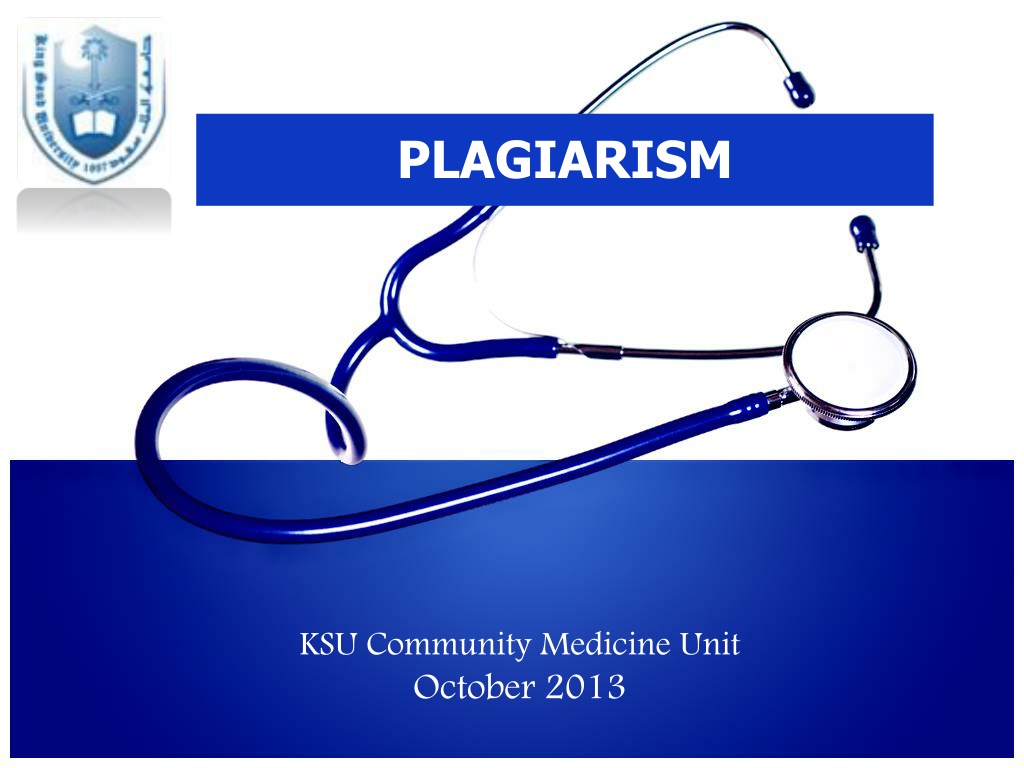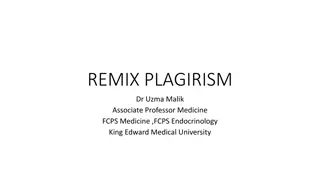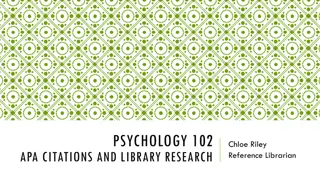Understanding Plagiarism: Types, Consequences, and Prevention
Plagiarism is the act of stealing someone else's work and presenting it as your own. This content covers the basic concepts, types, and examples of plagiarism, as well as how to avoid it. It emphasizes the importance of proper citation and intellectual property rights to prevent academic theft.
Download Presentation

Please find below an Image/Link to download the presentation.
The content on the website is provided AS IS for your information and personal use only. It may not be sold, licensed, or shared on other websites without obtaining consent from the author. Download presentation by click this link. If you encounter any issues during the download, it is possible that the publisher has removed the file from their server.
E N D
Presentation Transcript
PLAGIARISM KSU Community Medicine Unit October 2013
Objectives At the end of this lecture, the student should be able to: Describe the basic concepts / types of plagiarism Understand what is / is not plagiarism Discuss some examples of plagiarism Describe how to avoid plagiarism Plagiarism 2
Headlines Intellectual property Citation Definitions Classifications Examples of plagiarism Avoiding plagiarism Plagiarism 3
Intellectual Property Basically, a person s IDEAS and WORDS are owned by that person. Thus, written texts and the original ideas within them are considered to be intellectual property (Hacker) If you use an author s property , you must follow certain conventions. If you fail to do so, you STEAL someone else s property. Doing so is not only an ETHICAL offense, but also a LEGAL offense. Plagiarism 4
What is Citation? A "citation" is the way you tell readers that certain material in your work came from another source. It also gives your readers the information necessary to find that source again, including: information about the author the title of the work the name and location of the company that published your copy of the source the date your copy was published the page numbers of the material you are borrowing http://www.plagiarism.org/learning_center/what_is_citation.html
You Commit Plagiarism When You fail to cite quotations and borrowed ideas You fail to use quotation marks ( ) around another author s words, phrases, or sentences You fail to summarize or paraphrase in YOUR OWN WORDS
Definitions - Simply stated: theft of words - Presenting another s original thoughts or ideas as your own - Using another s exact words without proper citation - Presenting an idea as new and original when it comes from an existing source (Merriam-Webster Online Dictionary) - When you use another author s intellectual property language, visuals, or ideas in your own writing without giving proper credit, you commit a kind of academic theft called plagiarism (Hacker) Plagiarism 7
Classifications of Plagiarism First: intentional / non-intentional Second: words / structure / ideas / authorship / self Third: global / patchwork / incremental Plagiarism 8
FIRST CLASSIFICATION Plagiarism 9
Unintentional Plagiarism Paraphrasing poorly: changing a few words without changing the sentence structure of the original, or changing the sentence structure but not the words. Quoting poorly: putting quotation marks around part of a quotation but not around all of it, or putting quotation marks around a passage that is partly paraphrased and partly quoted. Citing poorly: omitting an occasional citation or citing inaccurately. Plagiarism 10
Intentional Plagiarism Passing off as one s own pre-written papers from the Internet or other sources. Copying an essay or article from the Internet, on-line source, or electronic database without quoting or giving credit. Cutting and pasting from more than one source to create a paper without quoting or giving credit. Borrowing words or ideas from other students or sources without giving credit. Plagiarism 11
SECOND CLASSIFICATION Plagiarism 12
Plagiarism: Type (1) WORDS of Definition The use of another s exact words without citing the author Incorrect Plagiarism is the reproduction of someone else s words, ideas or findings and presenting them as one s own without proper acknowledgement. Correct Plagiarism is the reproduction of someone else s words, ideas or findings and presenting them as one s own without proper acknowledgement Plagiarism 13
Plagiarism: Type (2) STRUCTURE Definition Paraphrasing another s words by changing sentence construction or word choice with citation Paraphrasing while maintaining original sentence construction with acknowledging the source Plagiarism 14
Plagiarism: Type (3) IDEAS Definition Presenting another s ideas as your own without giving the person credit Submitting a paper without citing or incorrectly citing another s ideas Plagiarism 15
Plagiarism: Type (4) AUTHORSHIP Definition Turning in a replication of another s work Submitting a paper that you got off the internet or from a friend and presenting it as your own Plagiarism 16
Plagiarism: Type (5) SELF Definition The use of previous work for a separate assignment Although these were your original words and thoughts, receiving credit for a previous assignment is considered cheating Plagiarism 17
THIRD CLASSIFICATION Plagiarism 18
Third Classification Global: stealing a speech entirely from a single source and passing it off as one s own Patchwork: stealing ideas or language from two or three sources and passing them off as one s own Incremental: failing to give credit for particular parts of a speech that are borrowed from other people Plagiarism 19
Challenge Plagiarized or acceptable writing?
Original Passage:Original Source The oldest and most familiar version of environmental concern might be called romantic environmentalism. Still a guiding spirit of the Sierra Club and the soul of the Wilderness Society and many regional groups, this environmentalism arises from love of beautiful landscapes: the highest mountains, deepest canyons, and most ancient forests. As a movement, it began in the late nineteenth century when America's wealthy discovered outdoor recreation and, inspired by writers like Sierra Club founder John Muir, developed a reverence for untamed places. For these American romantics, encounters with the wild promised to restore bodies and spirits worn down by civilized life. Shades of Green Author: Jedediah Purdy
Student Plagiarized or Acceptable? The type of environmentalism that most The type of environmentalism that most people are familiar with is also the oldest: people are familiar with is also the oldest: romantic environmentalism. This type of romantic environmentalism. This type of environmentalism leads the spirit and soul environmentalism leads the spirit and soul of the Sierra Club, the Wilderness Society of the Sierra Club, the Wilderness Society and other groups. People who follow and other groups. People who follow romantic environmentalism admire romantic environmentalism admire striking landscapes like tall mountains, striking landscapes like tall mountains, deep canyons, and old forests (Purdy) deep canyons, and old forests (Purdy)
Answer PLAGIARIZED! See next slide for explanation
What Went Wrong ? The type of environmentalism that most people are familiar with is also the oldest: romantic environmentalism. This type of environmentalism leads the spirit and soul of the Sierra Club, the Wilderness Society and other groups. People who follow romantic environmentalism admire striking landscapes like tall mountains, deep canyons, and old forests (Purdy). This is too similar to the original. The sentence structures and order of ideas are too similar to the original passage. The citation at the end is nice, but does not absolve the student from the responsibility of paraphrasing carefully. The yellow words were copied directly.
Original Source Most insects are cheap, tasty and a good natural protein source requiring less land and feed than raising cows or pigs. Many insects are far cleaner than other creatures. For example, grasshoppers and crickets eat fresh, clean green plants whereas crabs, lobsters and catfish eat any kind of foul, decomposing material as a scavenger (bottom water feeder). By weight, termites, grasshoppers, caterpillars, weevils, house flies and spiders are better sources of protein than beef, chicken, pork or lamb according to the Entomological Society of America. Also, insects are low in cholesterol and low in fat. Author: William F. Lyon, Insects as Human Food
Plagiarized or Acceptable? What s the ideal high-protein, low fat food? Surprisingly, the answer is insects. While most Americans could never imagine eating a big, juicy cockroach, insects actually taste good and can provide a good natural protein source. Insects also require less land and feed than raising cows or pigs. Plus, insects are more sanitary than livestock. The most difficult part of accepting insects as a healthy food is their appearance. However, many insects resemble crustaceans, and people have no problem eating shrimp, crabs, and lobster. Besides, insects are far cleaner than most sea creatures. While many insects eat only fresh, clean green plants, crabs, lobsters and catfish eat any kind of foul, decomposing material because they are scavengers (Lyon 12).
Answer PLAGIARIZED! See next slide for explanation
What Went Wrong ? The sections in yellow(below) are plagiarized the underlined parts are copied directly. The citation at the end acknowledges the information as Lyon s, but not the words and sentence structure. The writer needs to use quotes. What s the ideal high-protein, low fat food? Surprisingly, the answer is insects. While most Americans could never imagine eating a big, juicy cockroach, insects actually taste good and can provide a good natural protein source. Insects also require less land and feed than raising cows or pigs. Plus, insects are more sanitary than livestock. The most difficult part of accepting insects as a healthy food is their appearance. However, many insects resemble crustaceans, and people have no problem eating shrimp, crabs, and lobster. Besides, insects are far cleaner than most sea creatures. While many insects eat only fresh, clean green plants, crabs, lobsters and catfish eat any kind of foul, decomposing material because they are scavengers (Lyon 12).
More Examples Original Wording: "Such 'story myths' are not told for their entertainment value. They provide answers to questions people ask about life, about society and about the world in which they live" (10). Misuse of Source (1): Specifically, story myths are not for entertainment purposes rather they serve as answers to questions people ask about life, about society and about the world in which they live. Comment: The student copied words and phrases from the original without acknowledging their source. Although the student has rearranged some phrases and made minor stylistic changes, this version still follows the basic wording and structure of the original while the student repeats ideas as if they were his or her own. http://depts.drew.edu/composition/Avoiding_Plagiarism.htm
More Examples Original Wording: "Such 'story myths' are not told for their entertainment value. They provide answers to questions people ask about life, about society and about the world in which they live" (10). Misuse of Source (2): Davidson explains that story myths answer questions people ask about life, about society and about the world that we live in (10). Comment: Less obviously, this example is also classified as plagiarism. Although the student cites the source of the ideas, he or she presents Davidson's exact words as if he or she authored them. As is often the case in such plagiarism, where the words are changed the changes render the material less clear (shifting from they" to "we" for example). http://depts.drew.edu/composition/Avoiding_Plagiarism.htm
Strategies to Avoid Plagiarism Isolate the reasons why plagiarism occurs Identify the different types of plagiarism Integrate plagiarism prevention Cite sources when using Internet materials Take careful research notes Plagiarism 31
Plagiarism Prevention: Be Authentic Develop a topic based on previously written material but write something new and original Rely on opinions of experts on a topic but improve upon those opinions Give credit to researchers while making your own contribution Follow a standard documentation method Plagiarism 32
Plagiarism Prevention: 3 Word Rule If you copy 3 or more words exactly (word for word) from a source, you must use quotes around those words and immediately reference the source (use in-text citations) . Every phrase, sentence, or paragraph that you copy from another source must be enclosed in quotations; then, you must immediately provide a source. http://www.d.umn.edu/~tpederse/Docs/A-Plagiarism-Case-Study.htm
Plagiarism Prevention: Paraphrasing and Summarizing When taking notes, follow these steps: Read the information a couple of times Take notes in your OWN words WITHOUT LOOKING AT YOUR SOURCE If you want to quote an author, be sure to use quotation marks around an author s exact words.
Red Flag A major red flag that indicates plagiarism is the use of vocabulary not often used in your conversational, or everyday, language. Teachers can usually tell the difference between your own writing from another s, so be sure to give credit to your source.
Possible Penalties of Plagiarism Although plagiarism can be intentional or unintentional, both have consequences. Possible penalties include: Receiving zero on the assignment Failing the course in question Suspension from school / college Expulsion from academia Plagiarism 36
In Conclusion, Please Avoid: Copying and pasting complete papers from electronic sources Copying and pasting passages from electronic sources without placing the passages in quotes and properly citing the source Having others write complete papers or portions of papers for you Summarizing ideas without citing their source Pulling out quotes from sources without putting quotation marks around the passages Too closely paraphrasing - not putting the information in your own words (even if it's cited)
In Conclusion, Please Avoid: Quoting statistics without naming the source unless you gathered the data yourself Using words and passages you don't understand and can't explain Self-plagiarizing - using one paper for more than one class without the permission of your professors Making up sources Making up bibliographic or citation information (page numbers, etc.) Using photographs, video, or audio without permission or acknowledgment Translating from one language to another without properly citing the original source 3/10/2013 Plagiarism 38
SUMMARY: If you find yourself unable to write a few paragraphs about a topic without resorting to copying material from other sources, you are just not ready to write that paper . Simply rearranging the original text and/or altering a few word choices does not suddenly make you the author of an original work and free you of your intellectual debt . Simply paraphrasing an original text does not suddenly make you the author of an original work and free you of your intellectual debts . http://depts.drew.edu/composition/Avoiding_Plagiarism.htm 27 November 2024 Plagiarism 39
References Hacker, Diana. A Writer s Reference. 6th ed. Boston: Bedford/St. Martin s, 2007. MLA handbook for writers of research papers. (7th ed.). The Modern Language Association of America. New York: 2009. MLA Formatting and Style Guide from the OWL (Online Writing Lab) at Purdue: http://owl.english.purdue.edu/owl/resource/557/01/ Anything you ll ever need to know about plagiarism is here: http://www.plagiarism.org/learning_center/home.html Avoiding Plagiarism from Purdue s OWL site: http://owl.english.purdue.edu/owl/resource/589/01/ Lucas SE. Ethics and public speaking. McGraw-Hill, 2007 Pedersen, Ted. A Plagiarism Case Study. University of Minnesota Duluth. <http://www.d.umn.edu/ ~tpederse/Docs/A-Plagiarism-Case-Study.htm> Plagiarism and How to Avoid It! Drew University. <http://depts.drew.edu/composition/Avoiding_Plagiarism.htm>. What is Plagiarism? Plagiarism.org. http://www.plagiarism.org/learning_center/what_is_plagiarism.html Visit www.centralia.edu/academics/writingcenter/ Plagiarism 40























